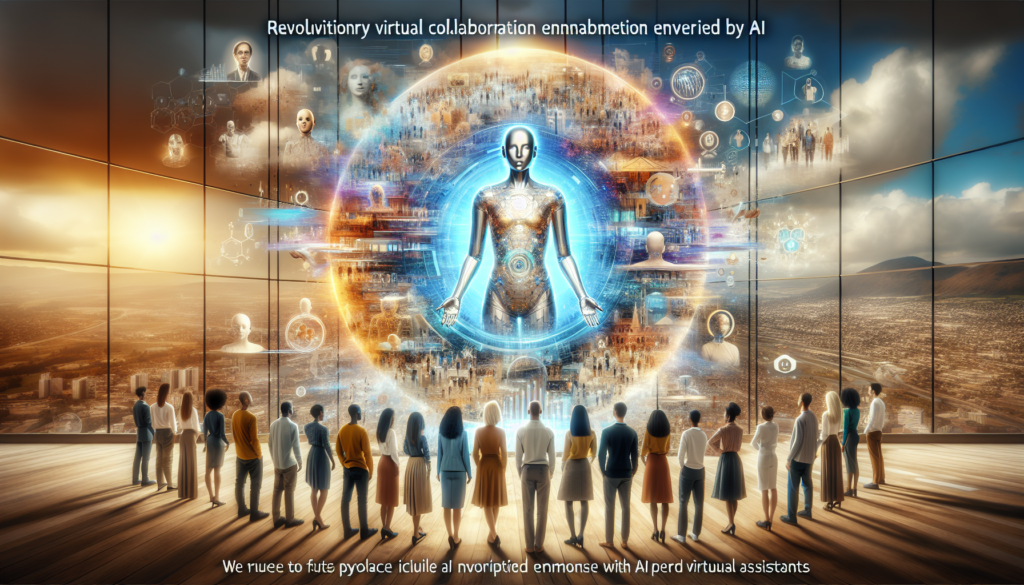Imagine a world where distance is no longer a barrier to collaboration, where teams effortlessly come together to work on projects regardless of their physical location. This is the future that awaits us, thanks to the advancements in Artificial Intelligence (AI) and virtual collaboration tools. In this article, we will explore how AI is revolutionizing the way we work and interact, making virtual collaboration more seamless, efficient, and engaging than ever before. Get ready to discover the exciting possibilities that lie ahead in the realm of virtual collaboration AI.

The Current State of Virtual Collaboration
Virtual collaboration, or the ability to work together remotely through digital platforms, has become an essential part of our modern work and communication practices. In the past, traditional methods of virtual collaboration relied heavily on email, phone calls, and web conferences to bridge the gap between team members who were physically located in different places. While these methods allowed for some level of collaboration, they often fell short in terms of efficiency, communication, and inclusivity.
Traditional methods of virtual collaboration
Traditional methods of virtual collaboration consisted mainly of email communication and web conferences. Emails were used to share documents, discuss ideas, and assign tasks, but they lacked the real-time interaction and quick response times that are often necessary for effective collaboration. Web conferences, on the other hand, allowed for face-to-face communication, but they were often plagued by technical issues such as poor audio and video quality, which hindered effective collaboration.
Limitations of traditional methods
The limitations of traditional virtual collaboration methods were evident in several aspects. Firstly, communication was often slow and asynchronous, as team members had to wait for responses to their emails or messages. This led to delays in decision-making and hindered efficient collaboration. Additionally, traditional methods lacked the ability to provide real-time feedback and updates, making it difficult for teams to work together seamlessly.
Furthermore, traditional virtual collaboration methods were not always inclusive, as they often required participants to have access to specific technologies or platforms. This created barriers for those who did not have access to the necessary tools and software, limiting their participation in collaborative efforts. Lastly, traditional methods also lacked the ability to leverage data and insights to improve collaboration and decision-making.
Introduction of AI in virtual collaboration
Enter artificial intelligence (AI), a game-changer in the world of virtual collaboration. AI has revolutionized the way we work together remotely, offering a range of benefits that were previously unimaginable. By leveraging AI technologies, virtual collaboration platforms have been able to overcome many of the limitations of traditional methods and enhance the overall collaboration experience.
The Benefits of AI in Virtual Collaboration
AI brings a wide range of benefits to virtual collaboration, transforming the way teams communicate, make decisions, and access information. Here are some key advantages of AI in virtual collaboration:
Improved communication and efficiency
AI-powered virtual collaboration tools offer advanced communication capabilities that enable teams to collaborate effectively in real-time. For example, virtual assistant chatbots can provide instant responses to queries, reducing the need for back-and-forth email exchanges. This improves efficiency by enabling faster decision-making and streamlined communication.
Additionally, AI can help automate routine tasks and workflows, freeing up time for teams to focus on more strategic and creative aspects of their work. Automated task management systems can assign and track tasks, reducing the need for manual coordination and enabling teams to work together seamlessly.
Enhanced decision-making
AI technologies can also significantly enhance decision-making in virtual collaboration. By analyzing large amounts of data and providing valuable insights, AI can support teams in making more informed and data-driven decisions. For example, AI-powered analytics tools can analyze project data and provide visualizations that help teams identify patterns, trends, and areas for improvement.
Furthermore, AI can enable predictive capabilities, allowing teams to anticipate potential challenges and proactively address them. This can help minimize risks and optimize the outcome of collaborative efforts. With AI-powered decision support systems, teams can make more accurate and impactful decisions, even when they are not physically present together.
Increased accessibility and inclusivity
One of the most significant benefits of AI in virtual collaboration is its potential to increase accessibility and inclusivity. AI-powered tools can provide real-time language translation, enabling teams that speak different languages to collaborate effortlessly. This breaks down language barriers and ensures that everyone can participate and contribute to the collaborative process.
In addition, AI can assist individuals with disabilities by providing accessibility features such as voice recognition and text-to-speech capabilities. This ensures that virtual collaboration platforms are inclusive and accessible to individuals with different needs and abilities.
AI-powered Tools for Virtual Collaboration
AI has given rise to a variety of powerful tools and platforms that enhance virtual collaboration. Here are some key AI-powered tools that are transforming the virtual collaboration landscape:
Virtual assistant chatbots
Virtual assistant chatbots are AI-powered tools that use natural language processing to interact with users and provide assistance. These chatbots can answer questions, provide information, and even perform specific tasks, all through a conversational interface. Virtual assistant chatbots enhance virtual collaboration by providing instant support and simplifying complex processes, thereby improving efficiency and reducing the need for manual coordination.
Automated task management systems
AI-powered task management systems automate the process of assigning, tracking, and organizing tasks within collaborative projects. These systems use AI algorithms to intelligently allocate tasks based on skill sets, availability, and priority levels. By automating task management, teams can ensure that everyone is on the same page, deadlines are met, and progress is tracked in real-time.
AI-powered video conferencing platforms
AI-powered video conferencing platforms leverage machine learning algorithms to enhance the video conferencing experience. These platforms can automatically adjust video and audio settings based on participants’ preferences and network conditions, ensuring optimal video quality and seamless communication. AI-powered video conferencing platforms also offer features such as automatic transcription and real-time translation, making them inclusive and accessible to a diverse range of users.
Implementation Challenges and Considerations
While AI brings tremendous benefits to virtual collaboration, its implementation also poses certain challenges and considerations. Here are some key factors to keep in mind when integrating AI into virtual collaboration:
Data privacy and security concerns
As AI-powered tools process and analyze large amounts of data, data privacy and security become critical considerations. Organizations must ensure that they have robust data protection measures in place to safeguard sensitive information. Additionally, it is essential to adhere to data privacy regulations and obtain users’ consent when collecting and using their data.
Ethical considerations
As AI technologies become more advanced, ethical considerations come to the forefront. Organizations must consider potential biases and unintended consequences that may arise from AI algorithms. Transparent and accountable AI systems are crucial to ensure fairness and to avoid perpetuating inequalities.
Integration with existing collaboration tools
Integrating AI-powered tools with existing collaboration tools and workflows can be a challenge. Organizations need to carefully assess their current infrastructure and processes to determine how AI can complement and enhance their existing virtual collaboration practices. Seamless integration and user-friendly interfaces are key to successful implementation and user adoption.

The Role of Machine Learning in Virtual Collaboration
Machine learning, a subset of AI, plays a crucial role in virtual collaboration. Here are some ways in which machine learning enhances virtual collaboration:
Training virtual assistants with machine learning
Machine learning algorithms are used to train virtual assistants, allowing them to understand and respond intelligently to user queries. Through continuous learning, virtual assistants can improve their accuracy and provide more personalized and relevant support to users. Machine learning enables virtual assistants to become smarter and more efficient over time.
Improving predictive capabilities
Machine learning algorithms can analyze historical data and patterns to make predictions about future outcomes. In the context of virtual collaboration, machine learning can help teams anticipate potential challenges, identify bottlenecks, and optimize collaboration processes. By leveraging machine learning algorithms, teams can make more accurate and informed decisions, leading to improved collaboration outcomes.
Personalization and customization
Machine learning algorithms can analyze user behavior and preferences to provide personalized experiences. In virtual collaboration, machine learning can be used to personalize user interfaces, suggest relevant content, and automate repetitive tasks based on individual preferences. This allows users to tailor their collaboration experience to meet their specific needs and preferences, enhancing overall engagement and productivity.
Virtual Reality and Augmented Reality in Virtual Collaboration
Virtual reality (VR) and augmented reality (AR) are technologies that have the potential to revolutionize virtual collaboration. Here are some ways in which VR and AR enhance virtual collaboration:
Enhancing the immersive experience
Virtual reality creates a fully immersive experience by simulating physical environments and interactions. In virtual collaboration, VR enables team members to work together in virtual spaces that closely resemble real-world locations. This creates a sense of presence and fosters collaboration by allowing participants to interact with each other and their environment in a natural and intuitive manner.
Improving real-time collaboration
Augmented reality overlays digital information onto the real world, enhancing the real-time collaboration experience. With AR, team members can view and interact with virtual objects and information while still being physically present in their real-world environment. This allows for seamless collaboration and knowledge sharing, as participants can annotate, manipulate, and share information in real-time.
Virtual collaboration in 3D environments
Virtual reality and augmented reality enable virtual collaboration in 3D environments, which offers new possibilities for visualization, design, and problem-solving. Team members can work together in immersive virtual spaces, manipulating objects, experimenting with different scenarios, and gaining insights through interactive visualizations. This enhances creativity, innovation, and collaboration in virtual settings.

The Future of Virtual Collaboration
The future of virtual collaboration holds exciting possibilities, with AI playing a central role in driving innovation. Here are some key trends and advancements to expect in the future:
Increasing automation and AI integration
As AI technologies continue to evolve, we can expect to see increasing levels of automation in virtual collaboration. AI-powered tools will continue to take on routine and repetitive tasks, allowing teams to focus on higher-level strategic activities. AI integration will become more seamless and intuitive, enabling teams to leverage the power of AI in their day-to-day collaboration.
Advancements in natural language processing
Natural language processing (NLP) is an area of AI that focuses on enabling computers to understand and interpret human language. Advancements in NLP will enable virtual collaboration tools to understand and respond to natural language queries and commands more accurately and contextually. This will enhance the conversational capabilities of virtual assistants and streamline communication in virtual collaboration settings.
Virtual collaboration in mixed reality environments
Mixed reality combines elements of both virtual reality and augmented reality, blurring the lines between the physical and digital worlds. In the future, we can expect to see virtual collaboration taking place in mixed reality environments, where physical and digital objects coexist seamlessly. This will enable even more immersive and interactive collaboration experiences, transforming the way teams work together remotely.
Potential Applications of AI in Virtual Collaboration
AI has the potential to transform various domains of virtual collaboration. Here are some key areas where AI can make a significant impact:
Education and online learning
AI-powered virtual collaboration tools can enhance online learning experiences by providing personalized learning materials, real-time feedback, and intelligent tutoring systems. Virtual assistants can assist students in navigating online courses and provide support throughout their learning journey. AI can also facilitate collaborative learning by connecting students and facilitating group projects and discussions.
Remote work and telecommuting
AI-powered tools enable remote teams to collaborate effectively and seamlessly, regardless of their physical location. Virtual assistant chatbots can facilitate communication and coordination, while AI-powered task management systems ensure efficient task allocation and progress tracking. AI-powered video conferencing platforms enhance the real-time collaboration experience, making remote work and telecommuting more productive and engaging.
Healthcare and telemedicine
AI can also revolutionize virtual collaboration in the healthcare sector. Virtual collaboration platforms powered by AI can enable healthcare providers to collaborate across disciplines and locations, improving patient care and outcomes. AI can assist in diagnosing conditions, analyzing medical images, and predicting disease progression. Telemedicine platforms with AI capabilities can enhance remote consultations and enable more accurate and timely medical advice.

Overcoming Barriers to Adoption
While AI holds great promise for virtual collaboration, there are still barriers to its widespread adoption. Here are some strategies for overcoming these barriers:
Educating and training users
To ensure successful adoption, organizations must invest in educating and training users on the benefits and capabilities of AI-powered virtual collaboration tools. Users need to understand how AI can enhance their work and how to effectively leverage these tools to improve collaboration and productivity. Ongoing training and support can help users overcome any initial resistance and promote a positive attitude towards AI.
Addressing resistance to change
Resistance to change is a common barrier when implementing new technologies. Organizations must proactively address concerns and misconceptions about AI to alleviate fears and resistance. Communicating the benefits of AI and involving users in the decision-making and implementation process can help create a sense of ownership and buy-in. Organizations should also provide continuous support and feedback channels to address any challenges that arise during the adoption process.
Collaboration with AI developers and experts
Collaboration between organizations and AI developers and experts is crucial for successful implementation of AI in virtual collaboration. Organizations should actively seek partnerships and collaborations with experts in AI and virtual collaboration to ensure that their tools and strategies align with industry best practices. This collaboration can help organizations stay at the forefront of AI advancements and leverage the expertise of AI professionals.
Conclusion
The future of virtual collaboration is collaborative and AI-driven. AI has the potential to revolutionize the way we work together remotely, offering improved communication, enhanced decision-making, and increased accessibility and inclusivity. With AI-powered tools such as virtual assistant chatbots, automated task management systems, and AI-powered video conferencing platforms, teams can collaborate more efficiently and seamlessly. Machine learning and AI algorithms enable personalized experiences, improved predictive capabilities, and smarter virtual assistants. Virtual reality and augmented reality enhance immersion and real-time collaboration in virtual settings. AI has applications in education, remote work, healthcare, and many other domains of virtual collaboration. While there are challenges to overcome, such as data privacy and security concerns, ethical considerations, and integration with existing tools, organizations can overcome these barriers through education, addressing resistance to change, and collaboration with AI experts. By embracing the potential of AI in virtual collaboration, we can create a future where collaboration knows no boundaries and is driven by intelligent technologies.
